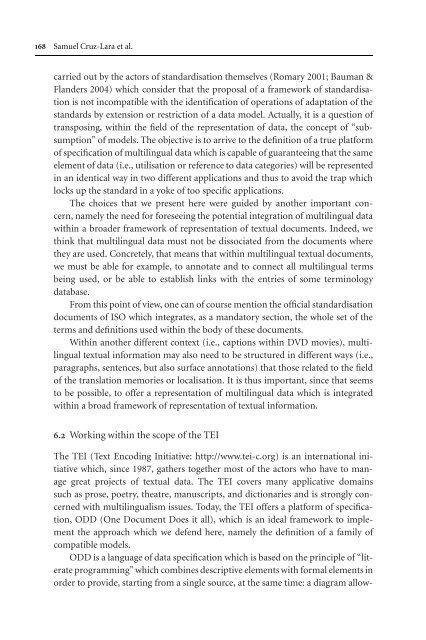Topics in Language Resources for Translation ... - ymerleksi - home
Topics in Language Resources for Translation ... - ymerleksi - home
Topics in Language Resources for Translation ... - ymerleksi - home
- No tags were found...
Create successful ePaper yourself
Turn your PDF publications into a flip-book with our unique Google optimized e-Paper software.
168 Samuel Cruz-Lara et al.carried out by the actors of standardisation themselves (Romary 2001; Bauman &Flanders 2004) which consider that the proposal of a framework of standardisationis not <strong>in</strong>compatible with the identification of operations of adaptation of thestandards by extension or restriction of a data model. Actually, it is a question oftranspos<strong>in</strong>g, with<strong>in</strong> the field of the representation of data, the concept of “subsumption”of models. The objective is to arrive to the def<strong>in</strong>ition of a true plat<strong>for</strong>mof specification of multil<strong>in</strong>gual data which is capable of guarantee<strong>in</strong>g that the sameelement of data (i.e., utilisation or reference to data categories) will be represented<strong>in</strong> an identical way <strong>in</strong> two different applications and thus to avoid the trap whichlocks up the standard <strong>in</strong> a yoke of too specific applications.The choices that we present here were guided by another important concern,namely the need <strong>for</strong> <strong>for</strong>esee<strong>in</strong>g the potential <strong>in</strong>tegration of multil<strong>in</strong>gual datawith<strong>in</strong> a broader framework of representation of textual documents. Indeed, weth<strong>in</strong>k that multil<strong>in</strong>gual data must not be dissociated from the documents wherethey are used. Concretely, that means that with<strong>in</strong> multil<strong>in</strong>gual textual documents,we must be able <strong>for</strong> example, to annotate and to connect all multil<strong>in</strong>gual termsbe<strong>in</strong>g used, or be able to establish l<strong>in</strong>ks with the entries of some term<strong>in</strong>ologydatabase.From this po<strong>in</strong>t of view, one can of course mention the official standardisationdocuments of ISO which <strong>in</strong>tegrates, as a mandatory section, the whole set of theterms and def<strong>in</strong>itions used with<strong>in</strong> the body of these documents.With<strong>in</strong> another different context (i.e., captions with<strong>in</strong> DVD movies), multil<strong>in</strong>gualtextual <strong>in</strong><strong>for</strong>mation may also need to be structured <strong>in</strong> different ways (i.e.,paragraphs, sentences, but also surface annotations) that those related to the fieldof the translation memories or localisation. It is thus important, s<strong>in</strong>ce that seemsto be possible, to offer a representation of multil<strong>in</strong>gual data which is <strong>in</strong>tegratedwith<strong>in</strong> a broad framework of representation of textual <strong>in</strong><strong>for</strong>mation.6.2 Work<strong>in</strong>g with<strong>in</strong> the scope of the TEIThe TEI (Text Encod<strong>in</strong>g Initiative: http://www.tei-c.org) is an <strong>in</strong>ternational <strong>in</strong>itiativewhich, s<strong>in</strong>ce 1987, gathers together most of the actors who have to managegreat projects of textual data. The TEI covers many applicative doma<strong>in</strong>ssuch as prose, poetry, theatre, manuscripts, and dictionaries and is strongly concernedwith multil<strong>in</strong>gualism issues. Today, the TEI offers a plat<strong>for</strong>m of specification,ODD (One Document Does it all), which is an ideal framework to implementthe approach which we defend here, namely the def<strong>in</strong>ition of a family ofcompatible models.ODD is a language of data specification which is based on the pr<strong>in</strong>ciple of “literateprogramm<strong>in</strong>g” which comb<strong>in</strong>es descriptive elements with <strong>for</strong>mal elements <strong>in</strong>order to provide, start<strong>in</strong>g from a s<strong>in</strong>gle source, at the same time: a diagram allow-
















